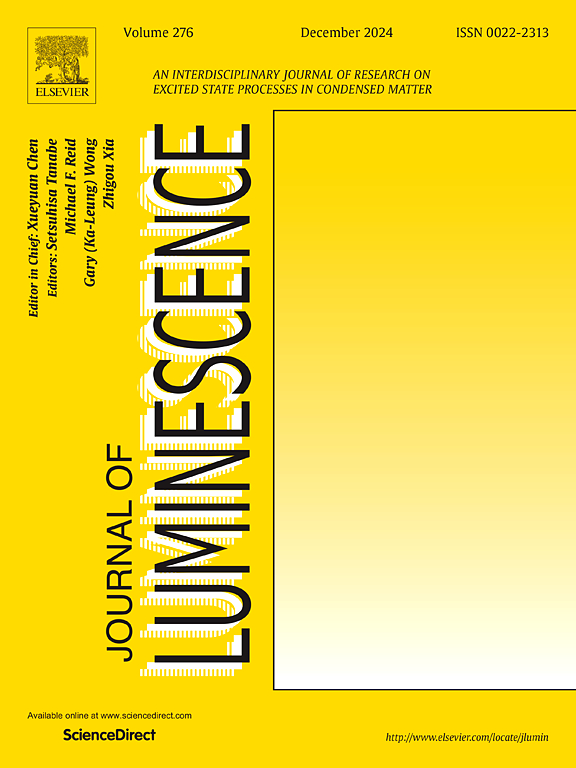A narrow-band green-emitting LaMgAl11O19:Ce3+, Mn2+ phosphor: Structure, energy transfer and luminescence
IF 3.3
3区 物理与天体物理
Q2 OPTICS
引用次数: 0
Abstract
A narrow-band green-emitting LaMgAl11O19: Mn2+, Ce3+ phosphor was synthesized through high-temperature solid-state reaction. The phase, luminescent properties, and energy transfer mechanism from Ce3+ to Mn2+ in LaMgAl11O19 were systematically investigated. The results reveal that Ce3+ ions serve as effective sensitizers for Mn2+ in LaMgAl11O19, leading to enhanced green emission at 525 nm, upon 320 nm excitation. The energy transfer from Ce3+ to Mn2+ is found to occur via dipole-dipole interactions, with a calculated critical transfer distance of 14.24 Å. The quantum efficiency of the optimized sample reaches 74.3 %, and the phosphor exhibits excellent thermal stability, retaining 92 % of its luminescence intensity at 150 °C. These results indicate the LaMgAl11O19: Mn2+, Ce3+phosphors exhibit high potential for wide color gamut white light-emitting diode (wLED) backlighting applications.
窄带绿色发光LaMgAl11O19:Ce3+, Mn2+荧光粉:结构、能量转移和发光
采用高温固相反应合成了窄带发光的LaMgAl11O19: Mn2+, Ce3+荧光粉。系统地研究了LaMgAl11O19中Ce3+到Mn2+的相、发光性质和能量转移机理。结果表明,Ce3+离子作为LaMgAl11O19中Mn2+的有效敏化剂,在320 nm激发下,在525 nm处的绿色发光增强。从Ce3+到Mn2+的能量传递是通过偶极-偶极相互作用发生的,计算出的临界传递距离为14.24 Å。优化后的样品的量子效率达到74.3%,荧光粉在150°C时表现出优异的热稳定性,保持了92%的发光强度。这些结果表明LaMgAl11O19: Mn2+, Ce3+荧光粉在宽色域白光发光二极管(wLED)背光应用中具有很高的潜力。
本文章由计算机程序翻译,如有差异,请以英文原文为准。
求助全文
约1分钟内获得全文
求助全文
来源期刊

Journal of Luminescence
物理-光学
CiteScore
6.70
自引率
13.90%
发文量
850
审稿时长
3.8 months
期刊介绍:
The purpose of the Journal of Luminescence is to provide a means of communication between scientists in different disciplines who share a common interest in the electronic excited states of molecular, ionic and covalent systems, whether crystalline, amorphous, or liquid.
We invite original papers and reviews on such subjects as: exciton and polariton dynamics, dynamics of localized excited states, energy and charge transport in ordered and disordered systems, radiative and non-radiative recombination, relaxation processes, vibronic interactions in electronic excited states, photochemistry in condensed systems, excited state resonance, double resonance, spin dynamics, selective excitation spectroscopy, hole burning, coherent processes in excited states, (e.g. coherent optical transients, photon echoes, transient gratings), multiphoton processes, optical bistability, photochromism, and new techniques for the study of excited states. This list is not intended to be exhaustive. Papers in the traditional areas of optical spectroscopy (absorption, MCD, luminescence, Raman scattering) are welcome. Papers on applications (phosphors, scintillators, electro- and cathodo-luminescence, radiography, bioimaging, solar energy, energy conversion, etc.) are also welcome if they present results of scientific, rather than only technological interest. However, papers containing purely theoretical results, not related to phenomena in the excited states, as well as papers using luminescence spectroscopy to perform routine analytical chemistry or biochemistry procedures, are outside the scope of the journal. Some exceptions will be possible at the discretion of the editors.
 求助内容:
求助内容: 应助结果提醒方式:
应助结果提醒方式:


